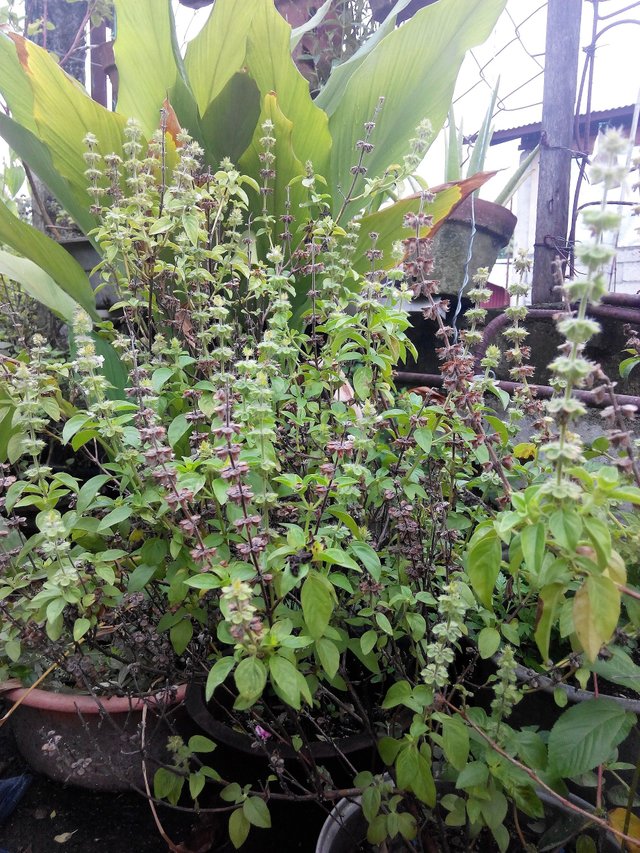The strong yet pleasant odour of the sweet basil is similar to the odor of lemongrass. That’s why in the absence of the lemongrass, sweet basil is always my best alternative when cooking. But sweet basil is more than just an alternative because on it own, it has a wealth of health benefits to the body, most especially to the digestive tracts and the lungs. And let me not forget its benefit to the lactating mother, as well.

Like the other herbs, this plant grows in open wastelands and thrives with minimal care. We grow this herb in a pot in our small rooftop garden. With its numerous seeds, sweet basil multiplies fast and can be propagated with less effort.
DESCRIPTION
Sweet basil plant stands erect and grows short branches. It is slightly hairy with slim stem structure. It can grow up to 1 meter high. Crushing the ovate-shaped fresh leaves, they give away a very aromatic scent similar to lemongrass. The flowers that bloom on stalks that can grow up to 15 cm long, the purplish or pinkish flowers hold the seeds that is used for medicinal purposes.
.jpg)
PARTS USED
The leaves, roots, and seeds have medicinal properties for several kinds of ailment.
ACTIVE ELEMENTS
There are quite a number of active elements in sweet basil: Eugenol, geraniol, linalool, ocimene, methylchavicol, eucalyptol, limonene, lipids, uronic acid, methylcinnamate, and galaturonic acid.
DOSAGE
Normal dosage. Please refer to the INTRODUCTION POST of this series.
Use 10 to 15 grams of the leaves or roots for 1 liter of water, 4-5 cups a day.
PRECAUTION AND SIDE EFFECTS
Sweet basil has its own side effects and users must be made aware what these side effects are. Please refer to the following link to get more details:
http://www.webmd.com/vitamins-supplements/ingredientmono-303-basil.aspx?activeingredientid=303&activeingredientname=basil
MEDICINAL USES
- Helps in relieving gas from stomach.
- Stimulates appetite.
- Prevent sudden involuntary muscle contractions.
- Aids in increasing secretion of milk during a mother’s lactation period.
- Helps remove mucus from bronchial tubes.
- Treats diarrhea, dysentery, and chronic constipation.
- May help cure whooping cough.
- Cures intestinal problems, stomach cramps and vomiting.
- Treats tuberculosis of the lungs.
PREPARATIONS
Decoction. Gently simmer the leaves or the crushed seeds for 30 minutes. The same preparation may be done with the roots.
Please refer to the INTRODUCTION POST of this series on how to prepare using decoction.
HOW TO USE
- Syrup from the decoction of the roots is used to treat tuberculosis of the lungs.
- Use the decoction of the leaves or seeds to increase milk secretion. The same can be used as compress on the nipple of the mammary glands.
- Decoction of the roots can help relieve bowel complaints in children.
- Use decoction of the leaves for other complaints.
Primary Reference: Amazing Healing Plants by JC Kurian
HAVE A HEALTHY, HAPPY LIFE.
Remember: When symptoms persist, consult a physician.
DISCLAIMER: All information, practices, and procedures have been PERSONALLY applied to my case. You may have different issues of the same symptoms, therefore, use the information here with caution. I am not a medical doctor nor a herbalist. But most of the applications have worked for me. It may work or may not work in your case. Consult a physician when in doubt.
Come follow @cjclaro for updates in this series of herbal medicine.

Wow .. superb benefits from this herb. Good post.
Downvoting a post can decrease pending rewards and make it less visible. Common reasons:
Submit
Thanks. I hope you get to use this herb when you need it.
Downvoting a post can decrease pending rewards and make it less visible. Common reasons:
Submit
Is it any way related to Holy Basil (Tulasi), because we use it a lot in India as a medicinal improtance as well as for holy reason.
Downvoting a post can decrease pending rewards and make it less visible. Common reasons:
Submit
Yes, Holy Basil is ocimum sanctum or ocimum tenuiflorum. They are very similar, actually. but in itself, holy basil has it own medicinal properties.
Downvoting a post can decrease pending rewards and make it less visible. Common reasons:
Submit
Ohh, thanks :) Good To Know
Downvoting a post can decrease pending rewards and make it less visible. Common reasons:
Submit
Love this post. I love basil and also had it in my garden. Love using it on the meats. I knew it is really good for your health, but didn't know most of the benefits. Thank you for sharing this great information. Can't wait to see more of your posts.
Downvoting a post can decrease pending rewards and make it less visible. Common reasons:
Submit
Interesting post!!
Downvoting a post can decrease pending rewards and make it less visible. Common reasons:
Submit
amazing
Downvoting a post can decrease pending rewards and make it less visible. Common reasons:
Submit
good
Downvoting a post can decrease pending rewards and make it less visible. Common reasons:
Submit
Excelente planta , sus propiedades y beneficios son especiales, ayudan al organismo. Aqui en nuestro país se da muy bien. Gracias por las recomendaciones amigo @cjclaro.
Downvoting a post can decrease pending rewards and make it less visible. Common reasons:
Submit
Muy buen artículo con excelentes consejos para la salud.
Como siempre, usted se destaca cada vez mejor.
Downvoting a post can decrease pending rewards and make it less visible. Common reasons:
Submit
Es bueno contar con consejos para salud como éstos. seguro nos evitarán lamentos futuros al prevenirlos con infusiones de plantas medicinales y usada por nuestros ancestros. Lo natural, es mejor, @@@cjclaro. Gracias por compartir este post.
Downvoting a post can decrease pending rewards and make it less visible. Common reasons:
Submit
Hey, @cjclaro. Are this plants in your own garden? It's really good because you can use when you are.
I likede this post, bro.
Downvoting a post can decrease pending rewards and make it less visible. Common reasons:
Submit